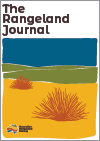Australia is dominated by 6 million km2 of rangelands that contribute significantly to the livestock industry and carbon market; yet, few studies have quantified the influence of grazing management on woody biomass and carbon stocks across these rangelands. Although grazing exclusion can sometimes facilitate carbon stock accumulation, it is difficult to predict when and where this would occur.
RJ24028 Abstract | RJ24028 Full Text | RJ24028PDF (1.6 MB) | RJ24028Supplementary Material (1.4 MB) Open Access Article





